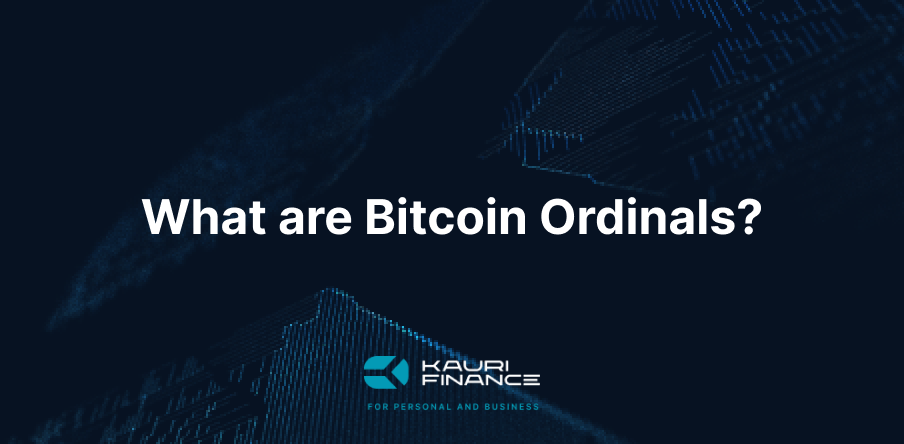
What Are Bitcoin Ordinals: Understanding the New Frontier in Blockchain Technology
- The Genesis of Bitcoin Ordinals
- How Bitcoin Ordinals Work
- The Impact of Ordinals on the Bitcoin Ecosystem
- Ordinals vs. Traditional NFTs: A Comparison
- The Future of Bitcoin Ordinals
- Investing in Bitcoin Ordinals: Opportunities and Risks
- Getting Started with Bitcoin Ordinals
- Frequently Asked Questions About Bitcoin Ordinals
- What exactly are Bitcoin Ordinals?
- How do Bitcoin Ordinals differ from traditional NFTs?
- Are Bitcoin Ordinals secure?
- Can I invest in Bitcoin Ordinals?
- What impact will Ordinals have on Bitcoin's network?
- How can I create my own Bitcoin Ordinal?

As we delve into the origins of Bitcoin Ordinals, we'll uncover the innovative minds behind this groundbreaking technology.
The Genesis of Bitcoin Ordinals
In early 2023, software engineer Casey Rodarmor revolutionized Bitcoin's landscape by introducing Ordinals. This innovation allows unique data to be inscribed onto individual satoshis, Bitcoin's smallest unit. Leveraging the SegWit upgrade's expanded block capacity and Taproot's enhanced smart contract capabilities, Ordinals opened new avenues for digital asset creation on the Bitcoin blockchain.
Now that we understand the genesis of Bitcoin Ordinals, let's explore how this fascinating technology actually works.
How Bitcoin Ordinals Work
Bitcoin Ordinals revolutionize digital scarcity by inscribing unique data onto individual satoshis, Bitcoin's smallest unit. This process leverages SegWit and Taproot to create novel digital assets directly on the Bitcoin blockchain.
-
Satoshi-level inscription: Each ordinal is tied to a specific satoshi
-
On-chain storage: Data permanently embedded in transactions
-
Censorship resistance: Inherits Bitcoin's security and decentralization
-
Programmability: Supports images, text, and executable code
-
Interoperability: Transferable like standard Bitcoin transactions
-
Scarcity: Only 2.1 quadrillion satoshis exist, limiting total possible ordinals
With a clear understanding of how Bitcoin Ordinals function, let's examine their profound impact on the Bitcoin ecosystem.
The Impact of Ordinals on the Bitcoin Ecosystem
Bitcoin Ordinals have revolutionized the cryptocurrency ecosystem, expanding Bitcoin's potential beyond financial transactions. By enabling the creation of unique digital assets on the Bitcoin blockchain, Ordinals have injected new vitality into the world's first cryptocurrency.
"Ordinals represent a paradigm shift, merging Bitcoin's unparalleled security with the creative potential of digital collectibles. This innovation could redefine Bitcoin's role in the broader blockchain landscape," explains Dr. Elena Nakamoto, a leading blockchain researcher.
This development has sparked debates about scalability and fees while attracting creators and investors. As we've seen the impact of Ordinals on Bitcoin, it's time to compare them with their more established counterparts: traditional NFTs.
Ordinals vs. Traditional NFTs: A Comparison
While Bitcoin Ordinals and traditional NFTs share the concept of digital ownership, they diverge significantly in implementation and ecosystem impact. Ordinals leverage Bitcoin's robust security, inscribing data directly onto satoshis, while traditional NFTs typically reside on separate blockchains, often Ethereum-based.
|
Feature |
Bitcoin Ordinals |
Traditional NFTs |
|
Blockchain |
Bitcoin |
Various (e.g., Ethereum) |
|
Scarcity |
Limited by satoshis (2.1 quadrillion) |
Platform-dependent |
|
Gas Fees |
Generally higher |
Variable, often lower |
|
Smart Contracts |
Limited functionality |
Extensive capabilities |
|
Ecosystem |
Emerging, Bitcoin-focused |
Established, diverse platforms |
This comparison highlights Ordinals' unique position, offering Bitcoin's security with NFT-like functionality. For crypto-savvy investors, Ordinals present a novel opportunity within the Bitcoin ecosystem.
Having compared Ordinals with traditional NFTs, let's peer into the future and explore what lies ahead for this innovative technology.
The Future of Bitcoin Ordinals
Bitcoin Ordinals herald a transformative era in blockchain utility, potentially revolutionizing identity verification and supply chain management. As smart contract capabilities evolve, Ordinals could rival Ethereum-based NFTs, attracting developers and fostering innovation. However, scalability challenges loom, with increased transaction volumes potentially straining Bitcoin's network. This may spur layer-2 solutions or protocol upgrades to meet growing demand. Ordinals' impact on Bitcoin adoption is dual-edged: attracting creatives while risking alienation of purists. This tension could reshape Bitcoin's trajectory, influencing its role in the digital asset landscape. As the technology matures, its full potential remains to be seen.
With a glimpse into the future of Bitcoin Ordinals, let's now consider the potential investment landscape they present.
Investing in Bitcoin Ordinals: Opportunities and Risks
Bitcoin Ordinals offer a unique investment landscape, blending Bitcoin's security with NFT-like attributes. This fusion presents opportunities and challenges for crypto-savvy investors:
-
Potential for significant value growth as adoption increases
-
First-mover advantage in Bitcoin-native digital collectibles
-
Diversification within the Bitcoin ecosystem
-
High volatility, offering profit potential and risk
-
Regulatory uncertainties and scalability concerns
-
Limited liquidity in early market stages
Investors should approach Ordinals cautiously, weighing potential rewards against evolving market dynamics.
Now that we've explored the investment potential of Bitcoin Ordinals, let's guide you through the process of getting started with this exciting technology.
Getting Started with Bitcoin Ordinals
Dive into Bitcoin Ordinals by setting up a compatible wallet like Sparrow or Xverse. Acquire Bitcoin for fees and inscriptions. Use tools such as Ord or Gamma.io to create Ordinals, inscribing data onto satoshis. Explore trading on specialized marketplaces like Ordinals Wallet or Magic Eden. Stay informed about emerging platforms in this rapidly evolving ecosystem.
As we conclude our journey through the world of Bitcoin Ordinals, let's address some frequently asked questions to solidify your understanding.
Frequently Asked Questions About Bitcoin Ordinals
What exactly are Bitcoin Ordinals?
Bitcoin Ordinals revolutionize digital assets by inscribing unique data onto satoshis, Bitcoin's smallest unit. Leveraging Bitcoin's robust blockchain, they create verifiable tokens that blend security with NFT-like creativity. Ordinals open new avenues for digital ownership within the Bitcoin ecosystem.
How do Bitcoin Ordinals differ from traditional NFTs?
Bitcoin Ordinals inscribe data onto satoshis, leveraging Bitcoin's security. Traditional NFTs exist on separate blockchains, offering advanced smart contracts. Ordinals inherit Bitcoin's scarcity, while NFT supply varies. Transaction fees and ecosystem maturity differ significantly between the two.
Are Bitcoin Ordinals secure?
Bitcoin Ordinals leverage the Bitcoin network's robust security, benefiting from decentralized consensus and cryptography. However, like all digital assets, they face risks from user errors, wallet vulnerabilities, or protocol exploits. Vigilant security practices remain crucial for Ordinal holders.
Can I invest in Bitcoin Ordinals?
Yes, you can invest in Bitcoin Ordinals. These unique assets offer Bitcoin ecosystem diversification. However, understand the risks: market volatility, regulatory uncertainties, and limited liquidity. Thorough research and cautious strategies are essential in this emerging space.
What impact will Ordinals have on Bitcoin's network?
Ordinals may intensify Bitcoin's network activity, potentially driving transaction fees and spurring scalability innovations. While attracting new users, they could spark debates about Bitcoin's core purpose, influencing its long-term evolution and adoption trajectory. This development presents both opportunities and challenges for the network.
How can I create my own Bitcoin Ordinal?
To create a Bitcoin Ordinal, use a compatible wallet like Sparrow or Xverse, have sufficient Bitcoin for fees, and utilize inscription tools such as Ord or Gamma.io. Select content, prepare the inscription, and execute. Be patient; network congestion may affect processing times.
